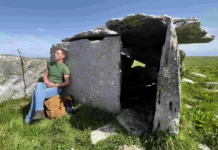Engineers from NUI Galway have developed a simple wearable device that has shown great benefits towards helping people with Parkinson’s stay mobile.
A clinical study found that a sensory electrical stimulation device significantly reduced the number of instances of Freezing of Gait in people with Parkinson’s as they completed walking exercises.
Freezing of Gait is one of the more debilitating motor conditions affecting people with Parkinson’s Disease that leaves them feeling like their feet are glued to the ground no matter how much they want to move forward.
Professor Gearóid Ó Laighin and the research team from the Human Movement Laboratory in CÚRAM at NUI Galway developed a device which can be worn easily around the waist to combat this.
The cueStim device was recently tested in an independent clinical assessment by the NHS Greater Glasgow and Clyde where it showed great promise.
The team at NUI Galway is now looking for clinical partners to join them in a long term study looking at how this can improve the quality of life of people with Parkinson’s according to Professor Ó Laighin.
Ms Lois Rosenthal from the NHSGGC said, “Freezing of gait is one of the most frustrating and difficult symptoms for patients to suffer and specialists to treat.”
“This common feature of Parkinson’s is not improved by Parkinson’s medications, and is inconsistently responsive to cueing techniques trialled by physiotherapists.”
This new approach shows great promise in tackling this intractable problem she added, and it now needs to be taken further to evaluate its “real-life practicality”.
The cueStim system was developed by Dean Sweeney as part of his PhD studies in the Discipline of Electrical and Electronic Engineering at NUI Galway.
Freezing of Gait came to prominence recently when comedian Billy Connolly spoke candidly about how it was affecting his life and his performances.
“I didn’t know how standing there would feel… I discovered that I got kinda rooted to the spot and became afraid to move,” the much loved comedian said.
“Instead of going away to the front of the stage and prowling along the front the way I used to do I stood where I was.”
The full study and its findings were recently published in the Journal of Healthcare Engineering.














